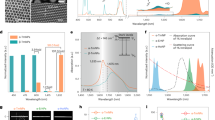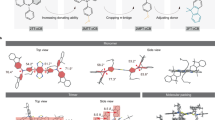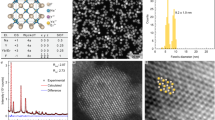Abstract
In vivo fluorescence imaging in the shortwave infrared (SWIR, 1,000–1,700 nm) and extended SWIR (ESWIR, 1,700–2,700 nm) regions has tremendous potential for diagnostic imaging. Although image contrast has been shown to improve as longer wavelengths are accessed, the design and synthesis of organic fluorophores that emit in these regions is challenging. Here we synthesize a series of silicon-RosIndolizine (SiRos) fluorophores that exhibit peak emission wavelengths from 1,300–1,700 nm and emission onsets of 1,800–2,200 nm. We characterize the fluorophores photophysically (both steady-state and time-resolved), electrochemically and computationally using time-dependent density functional theory. Using two of the fluorophores (SiRos1300 and SiRos1550), we formulate nanoemulsions and use them for general systemic circulatory SWIR fluorescence imaging of the cardiovascular system in mice. These studies resulted in high-resolution SWIR images with well-defined vasculature visible throughout the entire circulatory system. This SiRos scaffold establishes design principles for generating long-wavelength emitting SWIR and ESWIR fluorophores.

This is a preview of subscription content, access via your institution
Access options
Access Nature and 54 other Nature Portfolio journals
Get Nature+, our best-value online-access subscription
$29.99 / 30 days
cancel any time
Subscribe to this journal
Receive 12 print issues and online access
$259.00 per year
only $21.58 per issue
Buy this article
- Purchase on Springer Link
- Instant access to full article PDF
Prices may be subject to local taxes which are calculated during checkout





Similar content being viewed by others
Data availability
The datasets generated during and/or analysed during the current study are available in a public repository https://zenodo.org/records/10079855 and are also available from the corresponding authors on reasonable request. Further graphical data pertaining to photophysical properties, electrochemistry, photoluminescent lifetimes, computation, micelle photostability, nanoemulsions, in vivo imaging, synthetic procedures and NMR spectra are also available in the Supplementary Information. Raw data for animal experiments can be accessed on the BioImage archive #S-BIAD548. Source Data are provided with this paper.
References
Li, H., Wang, X., Li, X., Zeng, S. & Chen, G. Clearable shortwave-infrared-emitting NaErF4 nanoparticles for noninvasive dynamic vascular imaging. Chem. Mater. 32, 3365–3375 (2020).
Barton, J. B., Demro, J. C., Gasparian, G. & Lange, M. Performance of an Uncooled Camera Utilizing an SWIR InGaAs 256 × 256 FPA for Imaging in the 1.0 µm – 1.7 µm Spectral Band. Defense Public Release: Technical Report, ADA399438 (US Department of Defense, 1998).
Chinnathambi, S. & Shirahata, N. Recent advances on fluorescent biomarkers of near-infrared quantum dots for in vitro and in vivo imaging. Sci. Technol. Adv. Mater. 20, 337–355 (2019).
Hong, G., Antaris, A. L. & Dai, H. Near-infrared fluorophores for biomedical imaging. Nat. Biomed. Eng. 1, 0010 (2017).
Owens, E. A., Henary, M., El Fakhri, G. & Choi, H. S. Tissue-specific near-infrared fluorescence imaging. Acc. Chem. Res. 49, 1731–1740 (2016).
Tian, C. & Burgess, K. Flavylium and silylrhodapolymethines In excitation multiplexing. ChemPhotoChem 5, 702–704 (2021).
Usama, S. M. & Burgess, K. Hows and whys of tumor-seeking dyes. Acc. Chem. Res. 54, 2121–2131 (2021).
Wang, R., Li, X. & Yoon, J. Organelle-targeted photosensitizers for precision photodynamic therapy. ACS Appl. Mater. Interfaces 13, 19543–19571 (2021).
Liu, D. et al. Xanthene-based NIR-II dyes for in vivo dynamic imaging of blood circulation. J. Am. Chem. Soc. 17136–17143 (2021).
Kim, B., Kim, H., Kim, S. & Hwang, Y. R. A brief review of non-invasive brain imaging technologies and the near-infrared optical bioimaging. Appl. Microsc. 51, 9 (2021).
Wen, H. & Bellotti, E. Numerical study of the intrinsic recombination carriers lifetime in extended short-wavelength infrared detector materials: a comparison between InGaAs and HgCdTe. J. Appl. Phys. 119, 205702 (2016).
Vittadello, L. et al. NIR–to–NIR Imaging: extended excitation up to 2.2 um using harmonic nanoparticles with a Tunable hIGh EneRgy (TIGER) widefield microscope. Nanomaterials 11, 3193 (2021).
Sordillo, D. C., Sordillo, L. A., Sordillo, P. P., Shi, L. & Alfano, R. R. Short wavelength infrared optical windows for evaluation of benign and malignant tissues. J. Biomed. Opt. 22, 45002 (2017).
Carr, J. A. et al. Absorption by water increases fluorescence image contrast of biological tissue in the shortwave infrared. Proc. Natl Acad. Sci. USA 115, 9080 (2018).
Shapiro, A. et al. Tuning optical activity of IV–VI colloidal quantum dots in the short-wave infrared (SWIR) spectral regime. Chem. Mater. 28, 6409–6416 (2016).
Shi, X. et al. Zn-doping enhances the photoluminescence and stability of PbS quantum dots for in vivo high-resolution imaging in the NIR-II window. Nano Res. 13, 2239–2245 (2020).
Li, Y. et al. Novel NIR-II organic fluorophores for bioimaging beyond 1550 nm. Chem. Sci. 11, 2621–2626 (2020).
Sun, C. et al. J-Aggregates of cyanine dye for NIR-II in vivo dynamic vascular imaging beyond 1500 nm. J. Am. Chem. Soc. 141, 19221–19225 (2019).
Carr, J. A. et al. Shortwave infrared fluorescence imaging with the clinically approved near-infrared dye indocyanine green. Proc. Natl Acad. Sci. USA 115, 4465–4470 (2018).
Khan, Z. & Sekar, N. Far-red to NIR emitting xanthene-based fluorophores. Dyes Pigm. 208, 110735 (2022).
Rathnamalala, C. S. L. et al. Donor–acceptor–donor NIR II emissive rhodindolizine dye synthesized by C–H bond functionalization. J. Org. Chem. 84, 13186–13193 (2019).
Chatterjee, S. et al. SWIR emissive RosIndolizine dyes with nanoencapsulation in water soluble dendrimers. RSC Adv. 11, 27832–27836 (2021).
Chatterjee, S. et al. Design and synthesis of rhodIndolizine dyes with improved stability and shortwave infrared emission up to 1250 nm. J. Org. Chem. 87, 11319 (2022).
Grimm, J. B., Brown, T. A., Tkachuk, A. N. & Lavis, L. D. General synthetic method for Si-fluoresceins and Si-rhodamines. ACS Cent. Sci. 3, 975–985 (2017).
Best, Q. A., Sattenapally, N., Dyer, D. J., Scott, C. N. & McCarroll, M. E. pH−Dependent Si-fluorescein hypochlorous acid fluorescent probe: spirocycle ring-opening and excess hypochlorous acid-induced chlorination. J. Amer. Chem. Soc. 135, 13365–13370 (2013).
Huang, Y. L., Walker, A. S. & Miller, E. W. A photostable silicon rhodamine platform for optical voltage sensing. J. Am. Chem. Soc. 137, 10767–10776 (2015).
Zheng, Q. et al. Rational design of fluorogenic and spontaneously blinking labels for super-resolution Imaging. ACS Cent. Sci. 5, 1602–1613 (2019).
Kushida, Y., Nagano, T. & Hanaoka, K. Silicon-substituted xanthene dyes and their applications in bioimaging. Analyst 140, 685–695 (2015).
Liu, M. H., Zhang, Z., Yang, Y. C. & Chan, Y. H. Polymethine-based semiconducting polymer dots with narrow-band emission and absorption/emission maxima at NIR-II for bioimaging. Angew. Chem. Int. Ed. 60, 983–989 (2021).
Yang, Y. et al. Counterion-paired bright heptamethine fluorophores with NIR-II excitation and emission enable multiplexed biomedical imaging. Angew. Chem. Int. Ed. 61, e202117436 (2022).
Ando, N., Soutome, H. & Yamaguchi, S. Near-infrared fluorescein dyes containing a tricoordinate boron atom. Chem. Sci. 10, 7816–7821 (2019).
Lei, Z. et al. Synthesis of sterically protected xanthene dyes with bulky groups at C-3′ and C-7′. J. Org. Chem. 80, 11538–11543 (2015).
McNamara, L. E. et al. Indolizine-squaraines: NIR fluorescent materials with molecularly engineered Stokes shifts. Chem. Eur. J. 23, 12494–12501 (2017).
Ndaleh, D. et al. Shortwave infrared absorptive and emissive pentamethine-bridged indolizine cyanine dyes. J. Org. Chem. 86, 15376–15386 (2021).
Deng, F. & Xu, Z. Heteroatom-substituted rhodamine dyes: structure and spectroscopic properties. Chin. Chem. Lett. 30, 1667–1681 (2019).
Waggener, W. C. Absorbance of liquid water and deuterium oxide between 0.6 and 1.8 microns comparison of absorbance and effect of temperature. Anal. Chem. 30, 1569–1570 (1958).
Wang, S. et al. Anti-quenching NIR-II molecular fluorophores for in vivo high-contrast imaging and pH sensing. Nat. Commun. 10, 1058 (2019).
Cosco, E. D. et al. Flavylium polymethine fluorophores for near- and shortwave infrared imaging. Angew. Chem. Int. Ed. 56, 13126–13129 (2017).
Semonin, O. E. et al. Absolute photoluminescence quantum yields of IR-26 Dye, PbS, and PbSe quantum dots. J. Phys. Chem. Lett. 1, 2445–2450 (2010).
Kratkiewicz, K., Manwar, R., Zhou, Y., Mozaffarzadeh, M. & Avanaki, K. Technical considerations in the Verasonics research ultrasound platform for developing a photoacoustic imaging system. Biomed. Opt. Express 12, 1050–1084 (2021).
Friedman, H. C. et al. Establishing design principles for emissive organic SWIR chromophores from energy gap laws. Chem 7, 3359–3376 (2021).
Atallah, T. L. et al. Decay-associated Fourier spectroscopy: visible to shortwave infrared time-resolved photoluminescence. Spectra. J. Phys. Chem. A 123, 6792–6798 (2019).
Caspar, J. V., Sullivan, B. P., Kober, E. M. & Meyer, T. J. Application of the energy gap law to the decay of charge transfer excited-states. Solvent effects. Chem. Phys. Lett. 91, 91–95 (1982).
Siebrand, W. Radiationless transitions in polyatomic molecules. I. Calculation of Franck–Condon factors. J. Chem. Phys. 46, 440–447 (1967).
Siebrand, W. Radiationless transitions in polyatomic molecules. II. Triplet-ground-state transitions in aromatic hydrocarbons. J. Chem. Phys. 47, 2411–2422 (1967).
Caspar, J. V. & Meyer, T. J. Application of the energy gap law to nonradiative, excited-state decay. J. Phys. Chem. 87, 952–957 (1983).
Maillard, J. et al. Universal quenching of common fluorescent probes by water and alcohols. Chem. Sci. 12, 1352–1362 (2020).
Zheng, L., Polizzi, N. F., Dave, A. R., Migliore, A. & Beratan, D. N. Where Is the electronic oscillator strength? Mapping oscillator strength across molecular absorption. Spectra. J. Phys. Chem. A 120, 1933–1943 (2016).
Frisch, M. J., Pople, J. A. & Binkley, J. S. Self-consistent molecular orbital methods 25. Supplementary functions for Gaussian basis sets. J. Chem. Phys. 80, 3265–3269 (1983).
Lee, C., Yang, W. & Parr, R. G. Development of the Colle–Salvetti correlation-energy formula into a functional of the electron density. Phys. Rev. B 37, 785–789 (1988).
Becke, A. D. Density-functional thermochemistry. III. The role of exact exchange. J. Chem. Phys. 98, 5648–5652 (1993).
Frisch, M. J. et al. Gaussian 16, Revision A.03 (Gaussian, Inc, 2016).
Day, R. A., Estabrook, D. A., Logan, J. K. & Sletten, E. M. Fluorous photosensitizers enhance photodynamic therapy with perfluorocarbon nanoemulsions. Chem. Commun. 53, 13043–13046 (2017).
Cosco, E. D. et al. Bright chromenylium polymethine dyes enable fast, four-color in vivo imaging with shortwave infrared detection. J. Am. Chem. Soc. 143, 6836–6846 (2021).
Flock, S. T., Jacques, S. L., Wilson, B. C., Star, W. M. & van Gemert, M. J. Optical properties of Intralipid: a phantom medium for light propagation studies. Lasers Surg Med 12, 510–519 (1992).
Wang, F. et al. In vivo non-invasive confocal fluorescence imaging beyond 1,700 nm using superconducting nanowire single-photon detectors. Nat. Nanotechnol. 17, 653–660 (2022).
Rurack, K. & Spieles, M. Fluorescence quantum yields of a series of red and near-infrared dyes emitting at 600–1000 nm. Anal. Chem. 83, 1232–1242 (2011).
Lu, L. et al. NIR-II bioluminescence for in vivo high contrast imaging and in situ ATP-mediated metastases tracing. Nat. Commun. 11, 4192 (2020).
Ishchenko, A. A. et al. Electronic structure and spectral-fluorescent properties of thiopyrylo-4-tricarbocyanine laser dyes. Opt. Spectrosc. 129, 926–934 (2021).
Pengshung, M. et al. Silicon incorporation in polymethine dyes. Chem. Commun. 56, 6110–6113 (2020).
Soleymani, J., Zamani-Kalajahi, M., Ghasemi, B., Kenndler, E. & Jouyban, A. Solubility of sodium acetate in binary mixtures of methanol, 1-propanol, acetonitrile, and water at 298.2 K. J. Chem. Eng. Data 58, 3399–3404 (2013).
Acknowledgements
We thank the National Science Foundation (NSF; award no. 1757220 to W.E.M., D.N., A.K.S., N.I.H. and J.H.D.), the National Institute of Health (NIH; award no. 1R01EB027172 to E.M.S.), the Tobacco-Related Disease Research Program (TRDRP; award no. T32DT4847 to E.Y.L.), and the UCLA for the Dissertation Year Fellowship (I.L.) for their financial support. J.R.C. and H.C.F. would like to acknowledge National Science Foundation Career Award No. 1945572 and support from the Cottrell Award. This manuscript is based on work supported by the National Science Foundation Graduate Research Fellowship Program awarded to W.E.M. Any opinions, findings and conclusions or recommendations expressed in this material are those of the author(s) and do not necessarily reflect the views of the National Science Foundation. The funders had no role in study design, data collection and analysis, decision to publish or preparation of the manuscript. We would also like to acknowledge the late Douglas Hamm from HORIBA Scientific for his assistance in facilitating the fluorescence emission data acquisition in this study.
Author information
Authors and Affiliations
Contributions
W.E.M. synthesized the intermediates and fluorophores herein and collected absorption, emission, cyclic voltammetry measurements of the fluorophores along with the computational data. E.Y.L. and I.L. conducted the in vivo and capillary imaging experiments. H.C.F. conducted the photoluminescent lifetime experiments. D.N. synthesized compound 6. A.K.S. collected the emission spectrum and calculated the fluorescence quantum yield of SiRos1300. N.I.H. designed and supervised the fluorescence studies. B.Y. collected the fluorescence emission spectra for all fluorophores at HORIBA Scientific. J.R.C. designed and supervised the photoluminescent lifetime experiments. E.M.S. designed and supervised the in vivo and capillary imaging experiments. J.H.D. designed and supervised the design, synthesis and characterization of the fluorophores herein. W.E.M. wrote the initial draft of the manuscript and all authors assisted in editing subsequent drafts. All authors discussed the results and contributed to the paper.
Corresponding authors
Ethics declarations
Competing interests
W.E.M., D.N. and J.H.D. have a patent pending which includes the dyes studied herein, US Patent 20220370641A1. The remaining authors declare no competing interests.
Peer review
Peer review information
Nature Chemistry thanks Luke Lavis and the other, anonymous, reviewer(s) for their contribution to the peer review of this work.
Additional information
Publisher’s note Springer Nature remains neutral with regard to jurisdictional claims in published maps and institutional affiliations.
Extended data
Extended Data Fig. 1 Evaluation and comparison of SiRos1300 and SiRos1550 depth and resolution in 1% Intralipid relative to shorter wavelength SWIR-emitting dyes.
(A) Schematic of 1% Intralipid depth experiment. All dyes were initially brightness-matched in CH2Cl2 on the SWIR camera and subsequently imaged at 0.5 mm depth increments using a 1,300, 1,400, or 1,500 nm LP filter. (B) Intensity plots at each 0.5 mm depth normalized to the brightest dye when using a 1,300, 1,400, or 1,500 nm LP filter. Note that the increased baseline in the 1,300 LP images is due to stray excitation light.
Supplementary information
Supplementary Information
Supplementary figures, tables, discussion and chemical characterization data.
Source data
Source Data Fig. 3
Molar absorptivity and normalized and corrected emission spectra in dichloromethane.
Source Data Fig. 5
Absorption spectra of fluorophores in the nanoemulsions, cross-sectional intensities from mouse imaging experiments, and capillary brightness.
Source Data Extended Data Fig. 1
Capillary brightness data from depth penetration experiments.
Rights and permissions
Springer Nature or its licensor (e.g. a society or other partner) holds exclusive rights to this article under a publishing agreement with the author(s) or other rightsholder(s); author self-archiving of the accepted manuscript version of this article is solely governed by the terms of such publishing agreement and applicable law.
About this article
Cite this article
Meador, W.E., Lin, E.Y., Lim, I. et al. Silicon-RosIndolizine fluorophores with shortwave infrared absorption and emission profiles enable in vivo fluorescence imaging. Nat. Chem. (2024). https://doi.org/10.1038/s41557-024-01464-6
Received:
Accepted:
Published:
DOI: https://doi.org/10.1038/s41557-024-01464-6



